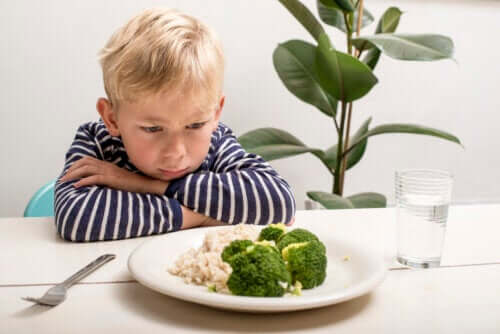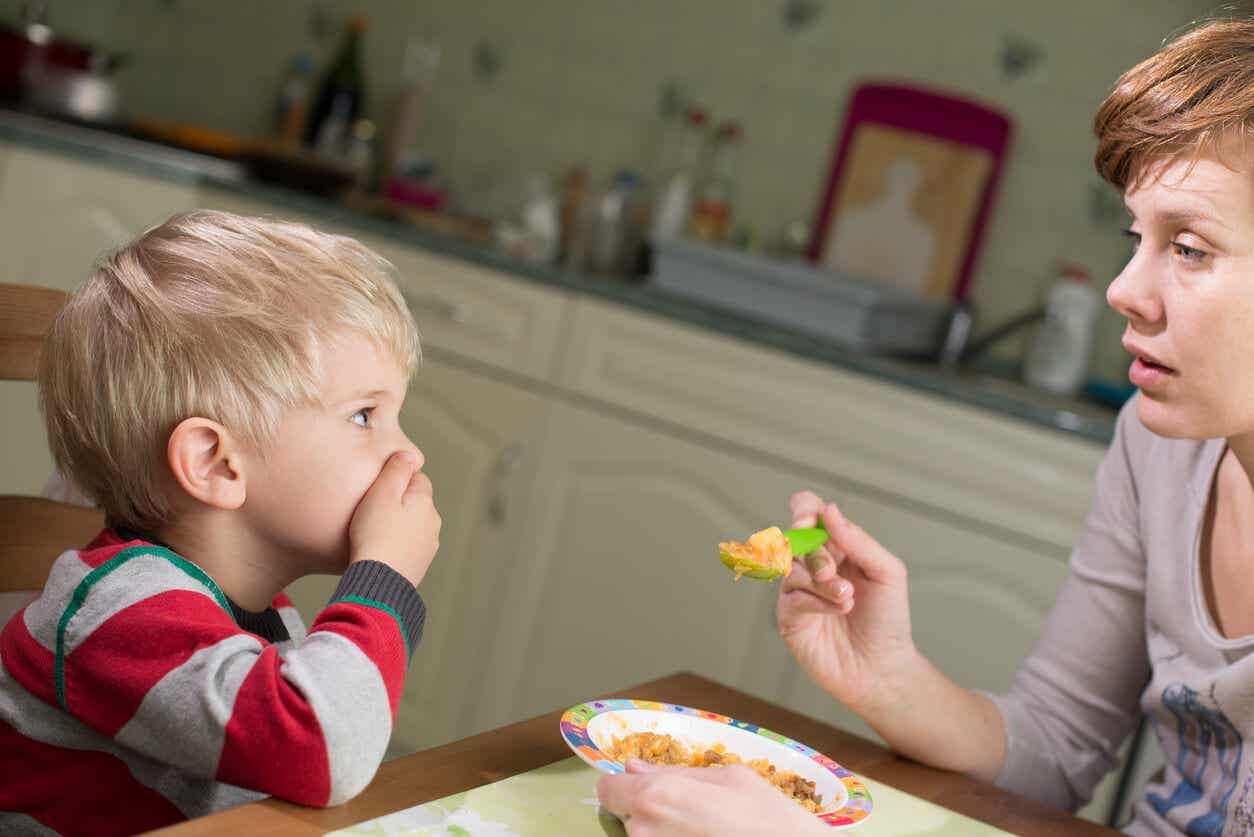A Baby’s Lack of Appetite After One Year of Age
Your one-year-old baby probably doesn't want to eat any of those foods they used to love. Don't worry! This lack of appetite is completely normal.

A baby’s eating habits change a lot after their first birthday. Even if parents offer the usual foods, the child may now reject them and show no interest in eating them. This lack of appetite has to do with age-related physical and mental changes. Many refer to it as an appetite slump.
From the first year of life onwards, a child’s body grows at a slower rate than before. This happens as a consequence of two independent processes: On the one hand, their metabolism “slows down” with respect to the rhythm of the first months of life. And, on the other hand, the level of physical activity increases as well as energy expenditure.
So, should you be concerned if, after the age of one year, your baby eats less than before? Probably not. Here are some useful tips to help you through this particular stage.
Characteristics of a baby’s physiological lack of appetite

Lack of appetite is to be expected at this age. According to estimates, about 30% of children aged 1 to 4 years show some kind of refusal to eat. However, only 1% of these have a disease (Lambrischini Ferri, 2007).
In fact, the Colombian doctor Ernesto Plata Rueda defines pseudo inappetence as the loss of appetite in a healthy child, who maintains a progression of weight and a level of activity adequate that’s adequate for their age.
It’s common for preschool children to show some kind of difficulty during feeding. While this isn’t a health problem, it’s a concern for parents and a source of family disputes at mealtimes.
One of the most prominent aspects of physiological inappetence is neophobia. This means ‘fear of the new’ and describes the tendency to avoid new foods. This condition appears very rarely in childhood, peaks between 2 and 5 years of age, and declines in adulthood.
While it’s somewhat cumbersome for parents, it’s presumed to be nothing more than a survival behavior of humans.
That’s because neophobia has a protective function. While humans need to consume a varied diet, the consumption of unfamiliar foods poses a risk of disease and toxicity (Rozin, 1976).
Therefore, in order to define food refusal as physiological, we must observe all of the conditions below:
- A healthy child who hasn’t shown signs or symptoms of digestive diseases.
- The child maintains a good progression regarding weight and height, according to the references for their age and sex.
- The child maintains a level of activity and mood that’s suitable for their age.
What can you do in the face of your child’s lack of appetite?
First of all, you should be aware that this is a transitory change that you can expect at this age. Just as you will have experienced infant colic or breastfeeding crises, you’ll understand that no matter how hard it is to cope with, one day, it’ll stop worrying you.
Here are some useful tips to put into practice whenever the situation becomes complicated.
Calm and patience
The relationship between parents and children helps to shape eating behavior. For this reason, the more tense the situation gets, the worse the outcome will be. And this applies not only to the quantity but also to the quality of food the child ultimately receives.
“…the best feeding strategies consist of encouraging the consumption of healthy foods without forcing their intake, restricting those that are less healthy, and ensuring a pleasant social environment.” (Falciglia, 2018).
For a child to incorporate a new food into their diet, you’ll need to offer it at least 5 to 10 times over time. It’s possible to modify food preferences if we provide the food on different opportunities (Birch, 1982).
Offer a variety of foods

All humans have preferences for certain foods and that’s not a bad thing at all. It’s also true that we tend to copy the eating habits of our parents or siblings, as we observe these behaviors for many years.
Besides social context and imitated behavior, there are genetic factors involved in food preferences.
In a study conducted by nutritionist Graciela Falciglia, she observed that the diets of children with greater neophobia were more restrictive than those of children without neophobia. In turn, these restrictive diets were significantly deficient in vitamins and high in saturated fats.
For this reason, whenever possible, it’s important to offer foods of all types. A useful way to achieve this is to ensure that there are many colors and textures on your child’s plate. This way, you’ll be providing a good variety of nutrients.
Make eating fun!
To have a good time, the context must be appropriate. It’s important to ensure a calm and relaxed atmosphere, without distractions (such as television or cell phones), where all diners can enjoy the experience.
It’s important to avoid arguments at mealtime or reproaches to the child for eating little or for eating too slowly or selectively. We must learn to respect their timing, their tastes, and their desire to finish quickly in order to go back to playing.
You must also be practical and not prolong the activity too much. If your child ate their meal eagerly, even if it was just a little, until they showed signs of being full, then at that moment, the meal should be considered over. Perhaps tomorrow they’ll stay at the table a little longer.
It’s better without tricks
If the goal is to get your child to adopt healthy eating habits, you shouldn’t focus on getting them to eat today everything you have in mind. Maybe they’ll do this over time… but it needs to be in their own time.
It’s important to talk to your pediatrician or a nutritionist about what nutrients are necessary for each stage of life and what foods you can find them in. Sometimes your child doesn’t need to drink a glass of milk as a source of calcium, as some vegetables, such as broccoli, can provide all the calcium your child needs.
Mixing various ingredients in a soup or sauce will certainly provide a variety of nutrients, but you’re definitely not teaching healthy eating habits.
Don’t force it
There’s no need to force your child to eat, nor should you threaten or bribe them. It’s important to provide the food and the necessary conditions for the child to adopt positive habits. On the contrary, any action under pressure can have negative consequences in the future.
About your baby’s physiological lack of appetite
Now that you’ve learned that this behavior is to be expected in children from 1 to 5 years old, you’ll be able to relax a little more at feeding time. Remember to consult your pediatrician on healthy eating issues, so as not to overlook certain aspects related to children’s nutrition.
